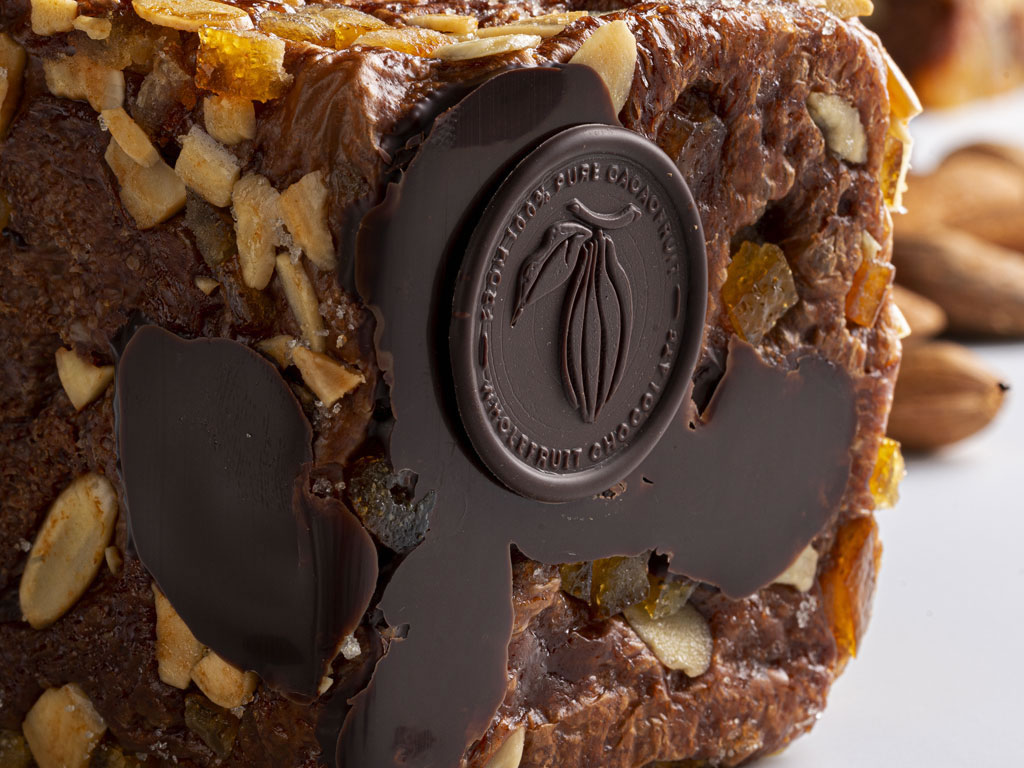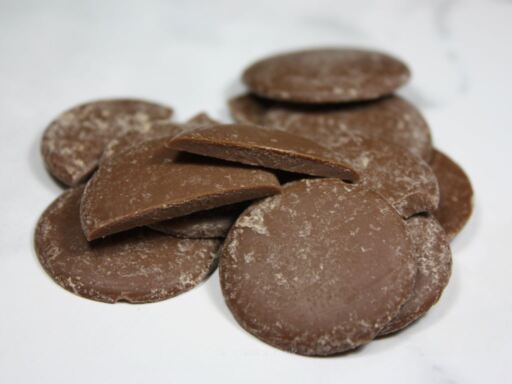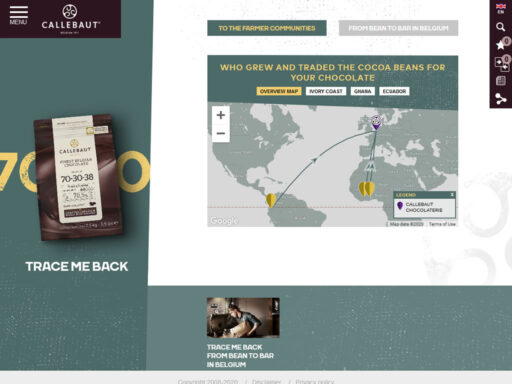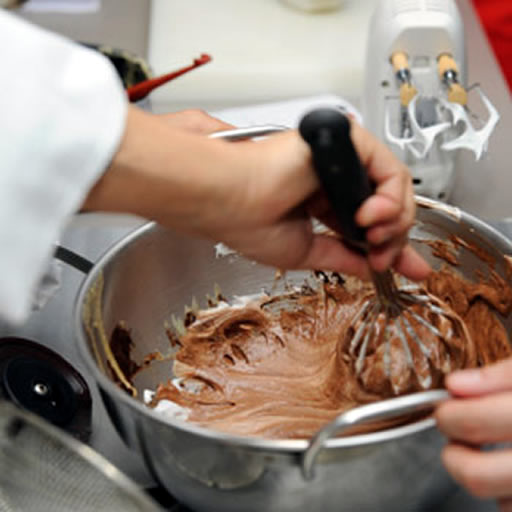In this article:
- What is WholeFruit Evocao Chocolate?
- How is WholeFruit Evocao Chocolate Made?
- Is All The Pulp And Peel Used in WholeFruit Evocao Chocolate?
- What Does WholeFruit Evocao Chocolate Taste Like?
- Is Evocao Technically Chocolate?
- Is WholeFruit Evocao Chocolate Suitable For Vegans?
- What Applications Best Suit WholeFruit Evocao Chocolate?
- What Can We Pair With WholeFruit Evocao Chocolate?
- Will WholeFruit Evocao Chocolate Ever Replace Regular Chocolate?
- Is Evocao's Packaging Sustainable and Recyclable?
Sustainability is a tremendously popular buzzword right now. As consumers, we want sustainable food, produced using sustainable practices, all presented in sustainable packaging. We are become more savvy about the contents, origins and processes behind the foods we buy, and we're demanding more sustainable and ethical alternatives.
While there are examples of sustainable chocolate production across the globe, the industry, on the whole, is not yet sustainable. It's also responsible for a tremendous amount of food waste. You see, chocolate relies on cacao beans - the seeds of the cacao fruit. The pulp and husks are usually discarded (although the pulp is sometimes consumed locally and is beginning to make its way more noticeably into our lives through cacao juice beverages).
To make a dent in the sheer volume of food waste created by chocolate manufacturing (and potentially tapping into an emerging health- and environmentally-conscious consumer market, cynics might say), in June 2021, Cacao Barry officially unveiled its first WholeFruit Chocolate product, named Evocao. The company extracts the natural sweetness from the cacao pulp and husks and combines with with the fermented beans to create a chocolate with minimal ingredients and no added sugars.
It's a game changer, so the marketing suggests. It's certainly an interesting product, and anything that helps increase sustainability while decreasing food waste should be celebrated. But are we heading for a world where WholeFruit Chocolate will become the norm, or is it a niche product reserved for chocolatiers and pastry chefs?
I sat in on a launch webcast, beamed globally from the Chocolate Academy in Montréal, to discover as much as I could about this new innovation.
What is WholeFruit Evocao Chocolate?
In a nutshell, Evocao is chocolate made with cacao mass and butter, sweetened with natural sugars extracted from the waste cacao fruit materials.

Evocao comprises of 72% cocoa solids (minimum), 40% cocoa butter content (minimum), and 22% sugars. It comes in 2.5kg bags of Pistoles (you might recognise this as couverture, callets, chocolate buttons or chocolate drops).
The WholeFruit chocolate range draws on Barry Callebaut's Cocoa Horizons sustainability programme. 450 farmers in Ecuador are engaged in the programme.
Nearly two years has passed since Cacao Barry announced its concept of WholeFruit chocolate made from 100% pure cacaofruit in San Francisco in September 2019. But we're nearly at the point where the product enters the marketplace.
Branded as 'upcycling', WholeFruit Chocolate makes use of cacao fruit pulp and peel that is normally discarded in favour of the seeds (cacao beans) to make chocolate. Cacao Barry estimates that 70% of cacao fruit typically goes to waste, claiming WholeFruit Chocolate upcycles 25% of that figure.
No additional refined or unrefined sugars are added to the product, besides a cacaofruit-derived sweetener. According to Cacao Barry, it has a Glycaemic index rating comparable to a standard 70% dark chocolate.
While Cacao Barry does not make any health claims, WholeFruit chocolate is said to contain around 40% less sugar than mainstream dark and milk chocolates. As it is made entirely from the cacao fruit, the resulting product should be nutrient-, vitamin- and mineral-rich, as well as a natural source of fibre. It'll be interesting to see whether scientists run diagnostics of WholeFruit chocolate against a regular 70% dark chocolate in due course, to compare and contrast the chemical and nutritional composition of each product.
How is WholeFruit Evocao Chocolate Made?
While marketed as a "natural" product, Evocao goes through industrial processing due to the scale of production.
Beans are fermented for around six days before being processed into cocoa mass and cocoa butter, while the cacao pulp and peel is processed by Cabosse Naturals, a Barry Callebaut company, into "a range of 100% pure cacaofruit ingredients".
The production of drying cacaofruit concentrate is a trade secret, although I imagine evaporation or distillation in some shape or form is used to separate the sugars (predominantly dextrose and fructose) from the waters. No chemicals are used in the production of WholeFruit chocolate, assures Cacao Barry.
There's a time limit on converting cacao pulp into useable ingredients of five hours, to preserve the nutrients and flavour.
The ingredients are married in various proportions to produce Evocao, the first in a line of WholeFruit chocolate products, with more expected variants to follow in due course.
You might expect the natural sugars in your chocolate bar or couverture to come from the same pod as the beans, but at the time of writing, the processes are distinct, so the natural sweetener is produced entirely separately to the cocoa mass and butter. In time, Cacao Barry hopes to marry the two, so the collective ingredients end up in the finished product.
Is All The Pulp And Peel Used in WholeFruit Evocao Chocolate?
While by-products are extracted from the pulp and peel, spent ingredients are output at the other end. Cacao Barry reckons 70% of the cacao fruit normally goes to waste, while these new processes use 25% of this waste to create natural ingredients.
Cabosse Naturals produces a trio of products:
- Cacaofruit Juice: A pale yellow, zesty, fruity, refreshing liquid ideal for adding an exotic flavour to drinks.
- Cacaofruit Juice Concentrate: A filtered and pasteurised golden brown liquid with a fruity honey fragrance which is a natural sweetener or flavouring agent for drinks, sorbets, ice creams, dairy products and confectionery.
- Cacaofruit Pulp: A whiteish substance that also exhibits a fruity honey fragrance and has applications in beverages, ice creams and sorbet products.
With a rise in the popularity of cacao fruit drinks and health-conscious products, I wonder if Barry Callebaut will look to partner with a major drinks producer in due course to create a new global market for its Cacaofruit Juice?
What Does WholeFruit Evocao Chocolate Taste Like?
I don't know. I've yet to sample it.
However, the tasting notes supplied by Cacao Barry and its Evocao launch ambassadors cite bitter, citrus, zesty and fruity flavour notes, with a long lasting aftertaste. Notes of lychee, orange and passion fruit are also pronounced.
Its official tasting profile notes suggest a strong sour and tangy quality, backed up by bold cocoa notes, yellow fruit, and citrus notes, with a degree of bitterness. Floral undertones punctuate hints of spiciness and red fruits at the baseline.
The marketing information suggests a dark chocolate with tropical fruit notes, evoking flavours such as mango, lemon, mandarin, passion fruit and cocoa fruit pulp. It also describes Evocao as "an expression of Dominican Republic and Ecuador cocoa fruits".
Overall, Evocao is heralded as a distinctive flavour, unrivalled by anything else.
Evocao launch ambassadors and chefs shared their opinions. Ramon Morató reckons it is "a festival of tropical fruits and citrus notes with fine cocoa flavours." Melissa Coppel picks up "notes of plums and raisins with a very clean chocolate taste." Meanwhile, Markus Bohr, Senior Executive Pastry Chef at Harrods, claims "Evocao is a different chocolate than any other [he's] tasted". Frank Haasnoot adds that it smells and tastes like a fresh cacao fruit, while Aurélien Trottier and Renata Arassiro echo appreciation of the freshness of the flavour.
Is Evocao Technically Chocolate?
You might remember that Ritter Sport was recently told by German regulators its 100% Cacao y Nada bar couldn't be called chocolate, as it contained no additional sugar. By definition, it needed to contain cocoa mass, cocoa powder, cocoa butter and sugar to be called chocolate.
Evocao, while free from refined or unrefined additional sugars, contains sugars derived from cacao pulp, so satisfies this definition.
In Australia, New Zealand, and Japan, it shall simply be known as "chocolate", made with cocoa mass and dry cacaofruit juice concentrate. In Brazil, it's "semi-bitter chocolate" made with cocoa liquor and dry cacao juice concentrate, while in the USA it's "semi-sweet chocolate" made with usweetended chocolate and dry cacaofruit juice concentrate.
Canadian customers will hear it called "Chocolate with cacaofruit juice concentrate" made with unsweetened chocolate and dry cacaofruit juice concentrate. Finally, European customers will search for "dark couverture chocolate" with an ingredients label containing cocoa mass and sugars obtained from cacao pulp (Theobroma cacao L.).
Is WholeFruit Evocao Chocolate Suitable For Vegans?
The recipe contains natural ingredients so can be considered vegan, but it is produced in a facility that handles milk products.
In Europe, it will be labelled as vegan, but in the United States of America and Japan it will not, due to "milk carry-over."
What Applications Best Suit WholeFruit Evocao Chocolate?
Based on the reactions of the tasting panel in the webcast, this dark chocolate appears to have a powerful, tart, fruity flavour, so it will lend itself to applications that require a robust chocolate flavour, either as an embellishment or as a secondary flavour. Its tropical, zesty, fruity characteristics will lend itself well to sweet applications and perhaps even savoury applications.

On the whole, it can be used for the same applications you would use chocolate couverture. Chocolate bars, chocolate buttons, chocolate bonbons, chocolate glazes, chocolate desserts, pastry work, and so on. Cacao Barry suggests a few of the main applications for this WholeFruit chocolate include:
- Chocolate mirror glazes and chocolate glazes for cakes or dipped fruits.
- Chocolate mousse and custard-based chocolate mousse.
- Chocolate ganache, which then has a multitude of applications, including truffles, desserts, macarons, and more.
- Chocolate Crème Pâtissière for use in pastry work.
- Chocolate brownies, tarts, muffins, biscuits, and cakes.
The temperature of the chocolate should not exceed 40°C when tempering. Exceeding this point affects the workability of the chocolate, as do environments that are too warm or too humid (over 70% relative humidity). The chocolate can be tempered on a marble slab, using the microwave method, seeding with Cacao Barry Pistoles, or by adding Callebaut Mycryo.
The company has successfully tested use of Evocao in a range of hot and cold drinks, so it should be an ideal candidate for a dark, rich hot chocolate.
While it's not suitable for ice cream dipping (as the ambient humidity will thicken the chocolate), it is suitable to use in chocolate and gelato recipes.
What Can We Pair With WholeFruit Evocao Chocolate?
Cacao Barry has put together a list of flavours Evocao WholeFruit chocolate should work with very well, enhancing the overall qualities of the pairings. Clearly, there will be many possibilities but these highlight tried-and-tested flavour combinations to begin your culinary experimentation.
- Citrus: Pink grapefruit and lemon.
- Fruits: Rhubarb, tomato, apples and gooseberries.
- Exotic fruits: Guava, papaya and mango.
- Herbs and botanicals: Basil, chamomile, lemongrass and laurel.
- Vegetables: yellow carrots and beetroot.
- Spices: Ginger and pink peppercorns.
- Beverages: Riesling wine, Sake, Muscat wine, Cassis, Earl Grey tea, or an IPA beer.
Will WholeFruit Evocao Chocolate Ever Replace Regular Chocolate?
That's the million dollar question. Prior to this event, I had naively anticipated a much larger launch, with large production volumes from the start. Instead, the availability is expected to be scarce until the end of the year when the wholesalers should get access to limited quantities. Until then, it appears to be exclusively available for just a small, lucky group of pastry chefs worldwide.
Supply and demand will govern the overall success of a product. While the concept of WholeFruit chocolate certainly has legs, this limited production run and availability will inhibit consumer demand. How are consumers supposed to demand more products be made with it if chocolate snack manufacturers can't get hold of it, let alone chocolatiers?
To begin, Cabosse Naturals is producing its cacaofruit ingredients in Latin America (in Ecuador and/or Dominican Republic, I believe). Until that production expands to the Ivory Coast and Ghana, where much of the world's bulk cocoa originates, supply will always be restricted.
As terroir imparts flavour into the cacao (both the beans and pulp), there's a good chance of different flavour profiles between Ecuadorian and Ghanaian cacaofruit ingredients, so this might be a limiting factor in ramping up global production.
Is Evocao's Packaging Sustainable and Recyclable?
That's a question I posed to the Cacao Barry team during the launch webcast. I didn't hear an answer. From the looks of it, the product is sealed inside the same film pouches as used by Callebaut and Cacao Barry for its couverture ranges. These are notoriously difficult to reuse or recycle, at least from a hobbyist perspective.
Many chocolatiers have turned to biodegradable plant-based plastics for their end-products. It would be great to see Cacao Barry (and Callebaut) look towards biodegradable and plant-based packaging, although finding something that' is durable enough to withstand manual handling in catering facilities while being a doddle to recycle or upcycle is likely a difficult task.
Do you think Cacao Barry WholeFruit Chocolate Evocao is revolutionary or evolutionary? Let me know your thoughts in the comments below.




